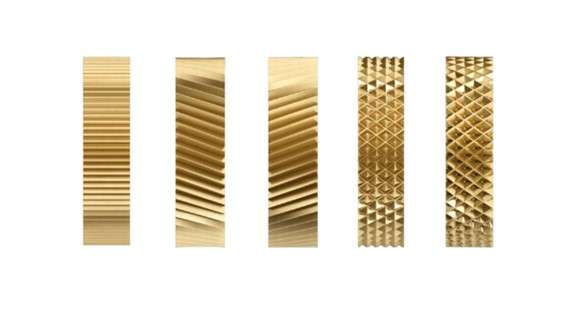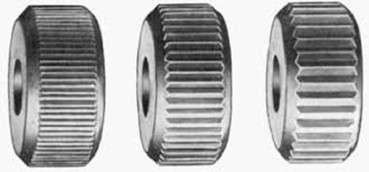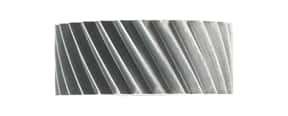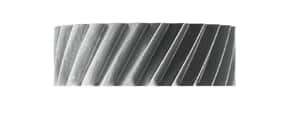
Different type of Knurling patterns
As a machinist, I’ve found that one of my favorite processes in the workshop is lathe knurling. There’s just something about the intricacy and precision of this technique that I find incredibly satisfying. In this article, I’ll share my passion for CNC knurling by discussing the process, various techniques, applications in different industries, and the benefits of knurled knobs and knob screws. So, if you’re ready to unlock the secrets of this fascinating process, let’s dive right in!
Knurling is a process used in machining to create a textured pattern on the surface of a workpiece. It is typically done on a lathe, which is a machine tool that rotates the workpiece on its axis to perform various operations like cutting, sanding, or drilling. Knurling is used to create a non-slip grip on the surface, making it easier to handle and operate. This is particularly useful in applications where secure grip and precise control are essential, such as in hand tools or knobs on machinery.
In the following sections, we will explore the different types of knurling techniques, discuss how they are applied in various industries, and delve into the benefits of using knurled knobs and knob screws. We will also look at the selection and usage of knurling wheels, as well as provide a step-by-step guide on how to knurl on a lathe. So, let’s get started!
Understanding the Knurling Process
Knurling is achieved by pressing a patterned tool, known as a knurling wheel, against the rotating workpiece. The wheel’s pattern is transferred to the workpiece’s surface, creating a series of raised ridges or indentations. The pressure applied during the knurling process must be carefully controlled to ensure a consistent pattern and depth across the workpiece. Too much pressure can cause deformation or damage to the workpiece, while too little pressure may result in an uneven or incomplete pattern. Once the knurling process is complete, the workpiece may require additional finishing, such as deburring or polishing, to remove any sharp edges or imperfections caused by the knurling process. Now that we have a general understanding of the knurling process, let’s explore the different techniques used to create various patterns and textures.
Types of Knurling Techniques
There are several knurling techniques that machinists can use to create different patterns and textures on their workpieces. Some of the most common techniques include:

Three straight knurling parts
- Straight Knurling (also known as standard Knurling): This technique involves rolling a single straight-patterned wheel along the workpiece, creating a series of parallel ridges. The result is a uniform, linear texture that offers a secure grip.

Left-hand diagonal knurl wheels

Right-hand diagonal knurl wheels
- Diagonal Knurling: Diagonal knurling is achieved by using two wheels with opposite diagonal patterns. The wheels are pressed against the workpiece simultaneously, creating a crisscross pattern. This technique produces a more aggressive texture than straight knurling, providing an even more secure grip.

Female diamond knurl wheels

Male diamond knurl wheels
- Diamond Knurling: This technique, also known as cross knurling, involves using two wheels with matching diagonal patterns. When pressed against the workpiece, the wheels create a diamond-shaped pattern. Diamond knurling is often considered the most attractive and visually appealing of the three techniques and offers an excellent grip.
Try Prolean Now!
Applications of Knurling in Various Industries

Knurled Handlebar
| Industry | Knurling Application |
|---|---|
| Automotive | Knurled shift knobs, steering wheel grips |
| Electronics | Knurled knobs for control panels, switches |
| Aerospace | Knurled handles for instruments, control levers |
| Medical | Knurled grips for surgical instruments, dental tools |
| Industrial | Knurled handles for tools, machine components |
| Consumer Goods | Knurled handles for kitchen appliances, home fixtures |
| Sports and Recreation | Knurled grips for sports equipment, fitness gear |
| Jewelry | Knurled textures for decorative purposes |
| Military/Defense | Knurled handles for firearms, tactical gear |
| Marine | Knurled knobs for marine equipment, handles for boating accessories |
knurling applications sorted by industry
Knurling is used in a variety of industries, including aerospace, automotive, and electronics, to name a few. Some common applications of knurling include:
– Creating a non-slip grip on hand tools, such as wrenches, screwdrivers, and pliers
– Adding texture to knobs and handles on machinery, making them easier to operate and control
– Providing a secure grip on fasteners, such as screws and bolts, to prevent them from loosening during vibration or movement
– Enhancing the aesthetics of a workpiece, such as decorative hardware or jewelry
The Benefits of Knurled Knobs and Knurled Knob Screws
Knurled knobs and knob screws offer several benefits, making them a popular choice in various industries. Some of these benefits include:
- Improved Grip: The textured surface created by knurling provides a secure grip, making it easier to tighten or loosen knobs and screws by hand.
- Increased Safety: The improved grip offered by knurled knobs and screws reduces the risk of slippage, making them safer to use in applications where precise control is critical.
- Aesthetics: Knurled knobs and screws are often considered more visually appealing than their smooth counterparts, adding a touch of sophistication and elegance to the finished product.
- Durability: The knurling process can increase the durability of knobs and screws, as the textured surface helps to distribute stress more evenly and reduce the risk of damage or deformation.
Knurling Wheels: Selection and Usage
The choice of knurling wheel is crucial in determining the quality and appearance of the finished knurl. Here are some factors to consider when selecting a knurling wheel:
- Pattern: Choose a wheel with the desired pattern, whether it’s straight, diagonal, or diamond.
- Pitch: The pitch, or the distance between the ridges on the wheel, will determine the spacing of the pattern on the workpiece. Select a pitch that will create the desired texture and grip on the finished product.
- Material: The wheel’s material should be compatible with the workpiece material to ensure smooth and even knurling. Common knurling wheel materials include high-speed steel and carbide.
When using a knurling wheel, it’s essential to keep the following tips in mind:
– Always use a sharp, clean wheel to ensure a crisp, well-defined pattern.
– Apply consistent and even pressure throughout the knurling process.
– Monitor the progress of the knurl to ensure even coverage and depth.
Step-by-Step Guide on How to Knurl on a Lathe
Now that we’ve covered the basics, let’s dive into a step-by-step guide on how to knurl on a lathe:
- Select and install the knurling tool: Choose the appropriate knurling wheel for the desired pattern and pitch, and install it on the lathe according to the manufacturer’s instructions.
- Prepare the workpiece: Mount the workpiece in the lathe and ensure it is properly secured and aligned. If necessary, apply a lubricant to the workpiece surface to reduce friction and heat during the knurling process.
- Set the lathe speed: Choose a suitable speed for the lathe, generally a slower speed for harder materials and a faster speed for softer materials.
- Begin knurling: Slowly advance the knurling tool towards the rotating workpiece until it makes contact with the surface. Apply consistent pressure as the wheel rolls along the workpiece, creating the desired pattern.
- Inspect the knurl: Periodically stop and inspect the knurl to ensure even coverage and depth. Make any necessary adjustments to the tool pressure or lathe speed.
- Finish the process: Once the desired knurl has been achieved, carefully remove the tool and workpiece from the lathe. Perform any necessary finishing steps, such as deburring or polishing, to complete the process.
Understanding the Purpose of Knurling in Design and Functionality
We’ve discussed various aspects of the knurling process, but it’s essential to understand the purpose behind knurling in design and functionality. The primary purpose of knurling is to enhance the grip and usability of an object. The textured surface created by knurling provides a secure, non-slip grip, making it easier to handle and operate, particularly in applications where precise control and safety are essential.
In addition to its functional benefits, knurling also serves a decorative purpose. The intricate patterns created by knurling can elevate the appearance of a workpiece, adding a touch of elegance and sophistication to the finished product.
Tips for Mastering Knurling Techniques
To become proficient in knurling techniques, consider the following tips:
- Practice: As with any skill, practice is crucial in mastering the art of knurling. Experiment with different materials, patterns, and pitches to hone your technique.
- Learn from others: Seek guidance from experienced machinists, whether through in-person workshops or online forums and videos. Learning from others’ experiences and expertise can help accelerate your progress.
- Maintain your tools: Keep your knurling wheels clean and sharp to ensure consistent, high-quality results. Regularly inspect and maintain your lathe and other equipment to prevent damage or inaccuracies during the knurling process.
Conclusion: Unlocking the Full Potential of Lathe Knurling
In conclusion, lathe knurling is a versatile and valuable skill for machinists to master. By understanding the various techniques, applications, and benefits of knurling, you can unlock the full potential of this intricate and precise process. Whether you’re creating a non-slip grip on hand tools, enhancing the functionality of knobs and screws, or adding a touch of elegance to a decorative piece, knurling is a powerful tool in any machinist’s arsenal. Looking for a skilled lathe knurling service supplier? Contact us for expert advice or let us handle your machining needs. Simply click ‘Get a Quote‘ to upload your drawings, and our engineers will respond within an hour with machining recommendations and a quote.
FAQ
What is lathe knurling?
Lathe knurling is a process used to create a pattern of raised lines or grooves on the surface of a workpiece using a lathe machine. It is often used to improve grip, aesthetics, or to create decorative patterns on cylindrical or round objects.
What materials can be knurled using a lathe?
Lathe knurling can be performed on a variety of materials, including metals such as steel, aluminum, brass, and copper, as well as certain plastics and other materials with sufficient hardness.
What are the different types of knurling patterns?
The most common types of knurling patterns are diamond, straight, and diagonal. Diamond knurling creates a pattern of diamond-shaped raised lines, straight knurling creates parallel straight lines, and diagonal knurling creates diagonal lines.
What are the benefits of knurling?
Knurling can provide improved grip on cylindrical objects, making them easier to handle or operate. It can also add aesthetic appeal or create decorative patterns on the surface of a workpiece.
What are some tips for successful lathe knurling?
A: Here are some tips for successful lathe knurling:
- Ensure that the workpiece and knurling tool are properly aligned and centered.
- Use the correct speed and feed rate for the material being knurled to avoid damaging the workpiece or the knurling tool.
- Apply cutting fluid or lubricant to reduce friction and heat during the knurling process.
- Use light, even pressure when feeding the knurling tool into the workpiece to achieve a consistent knurling pattern.
- Experiment with different knurling patterns, wheel sizes, and pressures to achieve the desired result.




0 Comments